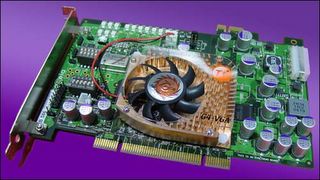AGEIA Physics Processor at E3

AGEIA Physics Processor at E3
We sat down the company and witnessed two demos running live on first-run, A0 silicon. The final silicon that will ship in boards is A1�AGEIA made a simple metal spin, but made no major changes to the silicon design. It'll be produced on a standard .13 micron CMOS process at TSMC. Who's going to build boards with this thing? So far, ASUS is the first to announce a partnership with AGEIA. They'll have a PPU board with AGEIA's chip on the market in the fourth quarter of this year, with 128MB of GDDR3 memory, for roughly $249 to $299. Initially, it will only come only in a PCI card, with PCIe cards expected further in the future.
The first demo was graphically simple, but still fairly impressive. A large rocky hillside had about 4,200 boulders dropped at the top, which all bounced, tumbled, and interacted in a realistic (and speedy) fashion. AGEIA claimed that a dual-core CPU can handle maybe 800-1,000 in a demo like this, but was quick to note that 4,200 boulders was nowhere near the capability of their chip. There's a driver issue right now where a lot of the timings need to be worked out between the massively parallel math units in the chip. Within a couple of months, the company will have a new driver which will enable them to raise the boulder count to 32,000. They're confident they can reach that number, but even if they can only get halfway there, 16,000 to 20,000 boulders is a lot better than a CPU can do.
Cool concept for sure, but another $300 on my gaming rig? Bastards! I have to admit that it could have a very dramatic effect ingames. I think I'll wait until I see a game running this one before jumping off the cliff.








0 Comments:
Post a Comment
<< Home